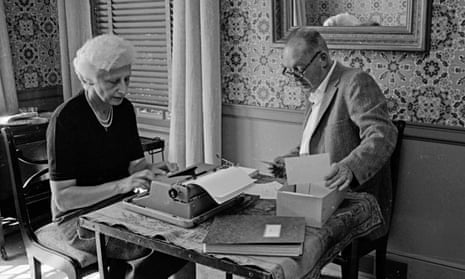What do we mean by “Nabokovian”? A deliciously rococo prose? Self-conscious Russian candyfloss? Nabokov’s masters were predominantly Russian: Gogol, Lermontov, Pushkin. In his maturity he came to see the loss of his ancestral Russia as the greatest ordeal of his life. The pre-revolutionary St Petersburg of his childhood was a city of sailor-suited privilege, with English nurses and governesses. Something of that rarefied upbringing was reflected in the Fabergé egg-like refinement of Nabokov’s fiction.
Prior to his death in 1977, Nabokov stipulated that his last, unfinished novel, The Original of Laura, be destroyed. Ignoring the injunction, his son Dmitri Nabokov and wife Véra consigned the manuscript to a Swiss bank vault and, in 2009, it was published. Flora, the heroine, reprises something of the girl theme of Lolita, Nabokov’s 1955 masterwork which Graham Greene, among others, had sought to rescue from threats of censorship. At one point she is molested by an older man named Hubert H Hubert, a homonymous near-miss to Humbert Humbert, the unsavoury charmer of Lolita.
For all its academic interest, the novel-from-the-grave was an unworthy coda to Nabokov’s finished works. Now we have Letters to Véra, covering half a century of the novelist’s correspondence to his wife from 1923 to 1977. A compelling record, it confirms Nabokov as possibly the most happily married writer of the 20th century. Every one of his books was dedicated to Véra; she was the sure centre of his world.
Though Véra destroyed her side of the correspondence, she remains a strong presence, and we can surmise what her letters said. Vladimir expresses irritation to her about her epistolary inertia (“I’m so cross with you that I’ve begun this letter without a salutation”), but is happy to deluge her with details of publisher contracts, his eating habits, psoriasis and neuralgia (though not, pointedly, an extramarital affair).
Nabokov met Véra at a charity ball in Berlin in 1923, when he was poised to make a name for himself as a poet and translator. Berlin émigré life was fraught with unease. Nabokov’s father, the liberal statesman VD Nabokov, had been assassinated at a political meeting in Berlin in 1922. He was, according to Trotsky, “an overstarched Englishman” and haughtily opposed to revolution. Vladimir Nabokov’s own dandyism – his butterfly collecting, the penchant for rocquefort cheese and pineapple – owed something to his father’s patrician stiffness.
Tinged with a sensuous immediacy of detail, Letters to Véra is a record of rapture. Véra is addressed variously as “Lumpkin”, “Tufty”, “Pupuss”, “Kittykin”, “monkeykins”, and even “Long bird of paradise with the precious tail”. She was born in St Petersburg in 1902 as Vera Slonim (the accent was added later), the daughter of a Jewish timber merchant and publisher. In her biography, Véra: Mrs Vladimir Nabokov, Stacy Schiff argues that the public Nabokov of Pale Fire, Speak, Memory and Lolita was essentially Véra’s creation. She alone saw to the translation and publication of her husband’s books, and even carried a gun to fend off unwanted journalists and other snoops. When Véra died in 1991, she had spent half a lifetime as Vladimir’s helpmeet and amanuensis.
She and Vladimir were rarely apart, but in 1926 they were separated for two months when she was sent to recuperate at a sanatorium in the Black Forest. Desperately unhappy, Vladimir sent more than 50 letters to her between 2 June and 19 July. (“My pet, I am the only Russian émigré in Berlin who writes to his wife every day.”) It was unsafe for Véra as a Jew to stay in Nazi Berlin, and in 1939 she and Vladimir moved to Paris. Nabokov made a couple of trips to London at this time, where he met the Ukraine-born émigrée Baroness Moura Budberg, the mistress of (among others) HG Wells, and “a stately, unflappable” salon fixture.
In the early 1940s Nabokov went on a lecture tour of America, leaving Véra on her own to look after their “boysie” Dmitri in Paris. Nabokov, who was neither pro-Tsar nor pro-Soviet, showed no sympathy at all for America’s ally “Uncle Joe” Stalin, but was quick to censor antisemitism or racial prejudice wherever he found it. (In Atlanta, to his amazement, he was asked if it was acceptable to talk about Pushkin’s “Negro blood”.) To amuse himself, Nabokov sent Véra puzzles and word games, a foreshadowing of his maddeningly opaque 1969 novel Ada, with its puns, anagrams and acrostics.
Superbly edited by Olga Voronina and Brian Boyd, these letters reveal Nabokov as a considerable wit, with a gift for terse put-downs and fascination with what remained outside his class and culture – whether it was Greyhound buses in Massachusetts or the New York subway. Now, perhaps for the first time, the Russian writer emerges distinct from the shadows of his biographers, and as one of the most uxoriously besotted writers of all time.
Letters to Véra is published by Penguin Classics (£30). Click here to buy it for £24

Comments (…)
Sign in or create your Guardian account to join the discussion